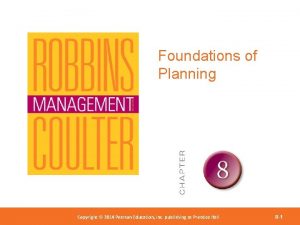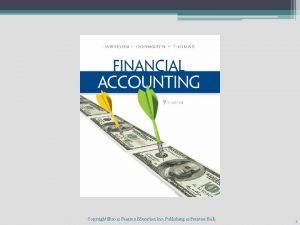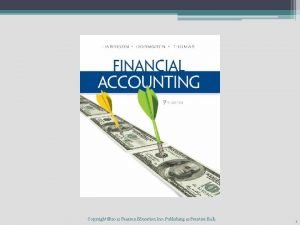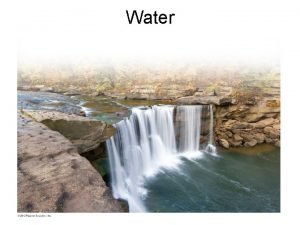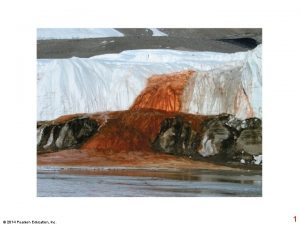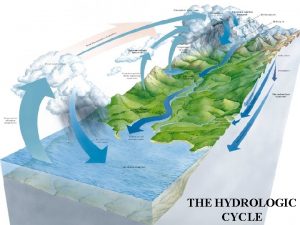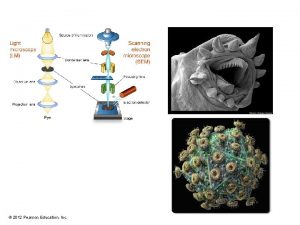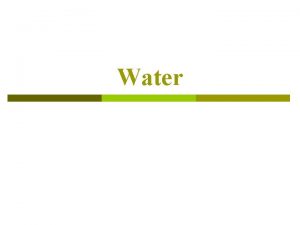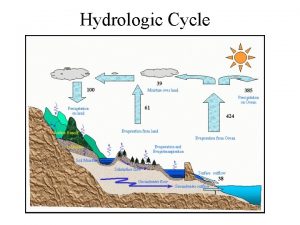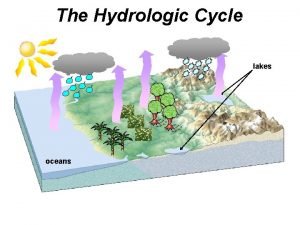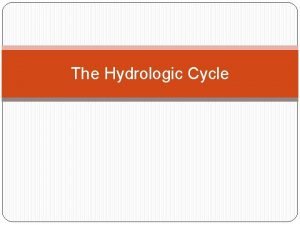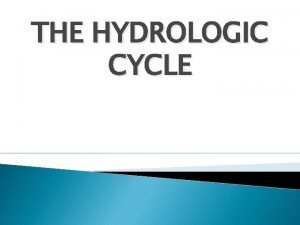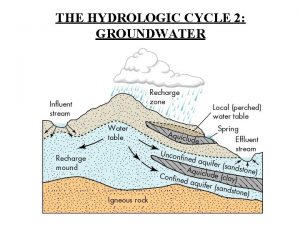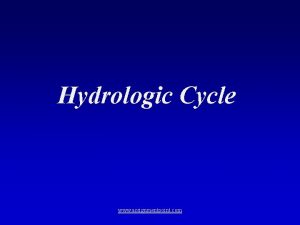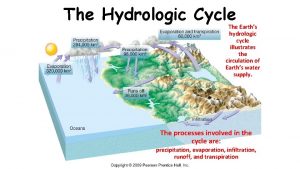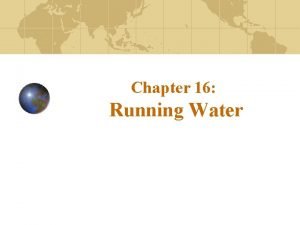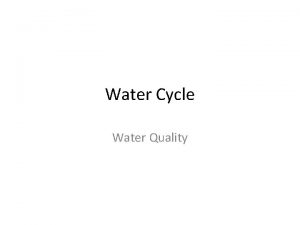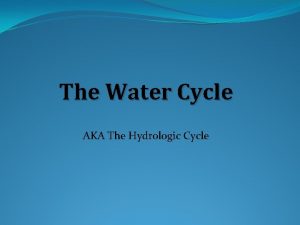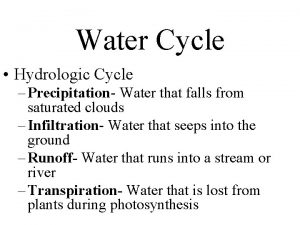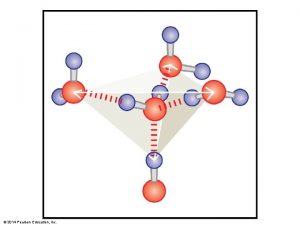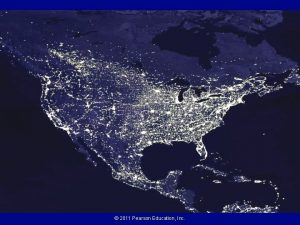Water 2012 Pearson Education Inc Hydrologic Cycle The



























- Slides: 27

Water © 2012 Pearson Education, Inc.

Hydrologic Cycle • The hydrologic cycle is a model that describes the movement of water through the reservoirs of the Earth • Processes involved in the hydrologic cycle • Precipitation • Evaporation • Infiltration • Runoff • Transpiration © 2012 Pearson Education, Inc.

Hydrologic Cycle Evaporation: Water changes from liquid to vapor Transpiration: Water taken up by plants passes into the atmosphere Condensation: Water changes from vapor to liquid Precipitation: Water returns to the surface of the earth as rain or snow. © 2012 Pearson Education, Inc.

Hydrologic Cycle Surface Runoff: precipitation that drains over the land or in streams Infiltration: Water works its way into the ground through small openings in the soil. © 2012 Pearson Education, Inc.

The Hydrologic Cycle © 2012 Pearson Education, Inc.

Sources of Earth’s water © 2012 Pearson Education, Inc.

Streamflow • Surface Runoff begins as overland or sheet flow as precipitation moves downhill • Sheet flow eventually becomes a stream water that flows downslope along a clearly -defined natural pathway. © 2012 Pearson Education, Inc.

Streamflow Characteristics • Stream gradient - steepness of the slope. The gradient is highest near the stream’s headwaters (source) and decreases as it moves downslope toward the ocean. • Stream discharge - the amount of water passing any point during a unit of time (example: ft 3/sec). • Stream load – suspended and dissolved sediment carried by the stream. © 2012 Pearson Education, Inc.

Types of Stream Channels - Straight Channel – Usually occur only in short stretches – Generally have a high gradient (near headwaters) – Classic Vshaped valley (as opposed to glacial U-shaped valley) © 2012 Pearson Education, Inc.

Types of Stream Channels- Braided Channel – Low gradient – Large, variable sediment load that varies seasonally (e. g. snowmelt, storm activity) © 2012 Pearson Education, Inc.

Types of Stream Channels- Meandering Channel – Usually occur downstream, near the mouth – Low gradient – Cut bank erosion and point bar deposition – May eventually form an oxbow lake © 2012 Pearson Education, Inc.

– Form when the meanders get too close together. – River cuts a new, direct channel between the meanders. Meandering Channel – Oxbow lake will eventually become a swamp and dry up. Oxbow Lake © 2012 Pearson Education, Inc.

Stream Deposits Floodplain – Flat valley floor adjacent to the stream, which is inundated when the stream overflows its banks Alluvium – unconsolidated sediment deposited by the stream © 2012 Pearson Education, Inc.

Stream Deposits – Alluvial Fans • Rapid change from high gradient to low gradient environment causes stream to slow down and drop its sediment load. • Fan-shaped deposit as water escapes its channel. • Often found in arid to semiarid environments with infrequent rainfall/flash flood conditions. © 2012 Pearson Education, Inc.

Stream Deposits – Delta • Similar to an alluvial fan, but found at the mouth of the stream • Fan-shaped deposit as stream flows into ocean and slows down, dropping its sediment load. • Distinctive fan-shape looks like the Greek letter delta: Δ © 2012 Pearson Education, Inc.

Drainage Basins • Drainage Basin: The total land area that contributes water to a stream. Also called a watershed, or catchment basin. • The drainage pattern consists of the interconnected network of streams in an area • A drainage basin of one stream is separated from the drainage basin of another by an imaginary line called a divide. © 2012 Pearson Education, Inc.

Successive drainage basins: The Yellowstone, Missouri, and Mississippi © 2012 Pearson Education, Inc.

Mississippi River Drainage Basin © 2012 Pearson Education, Inc.

Surface water resources • Fresh water supply – Essential for • Direct human consumption • Crop and livestock • Industry • Many populations around the world lack access to clean drinking water • Cause of socio-political conflicts – Scarcity of water resources © 2012 Pearson Education, Inc.

Water-related conflicts in California • Colorado River Compact among 7 states • Dispute between Imperial County and San Diego. • Effect of Los Angeles Aqueduct on Mono Lake, Owens River Gorge © 2012 Pearson Education, Inc.

Groundwater - Subsurface water contained in pore spaces in sediment and rock • Zone of aeration (vadose zone): pore space mainly filled with air • Saturated zone (phreatic zone): pore space filled with water • Water Table: Top surface of the saturated zone © 2012 Pearson Education, Inc.

Groundwater • Groundwater moves through the interconnected pore spaces of rock and sediment from areas of higher pressure to areas of lower pressure • Rock porosity – Relative amount of space in underground rock • Rock permeability – Ease of flow through rock © 2012 Pearson Education, Inc.

Groundwater • Water table tends to mimic topography • The water table comes up to the surface at streams, springs, and lakes © 2012 Pearson Education, Inc.

Discharge and Recharge • Water percolation - Process of water seepage through rocks and sediment • Recharge - Replenishment of groundwater • Discharge – process of water moving from the subsurface to the surface. © 2012 Pearson Education, Inc.

Aquifers and Aquicludes • Aquifer – Saturated rock or sediment that is porous and permeable, so able to be accessed by well. • Aquiclude – Layer of impermeable rock or sediment from which water cannot be drawn © 2012 Pearson Education, Inc.

Types of Aquifers • Unconfined aquifer – Water table not protected from surface recharge – Vulnerable to surface and near surface contamination – Well water rises to water table and must be pumped to surface • Confined aquifer – Protected from surface by aquiclude, – Recharge area is often distant – Water under pressure and rises above water table in well © 2012 Pearson Education, Inc.

Artesian Well – Well which accesses water from a confined aquifer – Water rises in artesian wells without pumps due to release of confining pressure – Less likely to be contaminated by surface runoff, but otherwise the same H 2 O. © 2012 Pearson Education, Inc.
 Water cycle the hydrologic cycle
Water cycle the hydrologic cycle Pearson education 2012
Pearson education 2012 2012 pearson education inc
2012 pearson education inc Pearson education 2012
Pearson education 2012 2012 pearson education inc
2012 pearson education inc Cephalic cranial
Cephalic cranial 2012 pearson education inc
2012 pearson education inc Pearson education inc. 2012
Pearson education inc. 2012 2012 pearson education inc anatomy and physiology
2012 pearson education inc anatomy and physiology 2012 pearson education inc
2012 pearson education inc 2012 pearson education inc
2012 pearson education inc Pearson education 2012
Pearson education 2012 2012 pearson education inc
2012 pearson education inc Pearson education inc. 2012
Pearson education inc. 2012 2012 pearson education inc
2012 pearson education inc 2012 pearson education inc
2012 pearson education inc Pearson education 2012
Pearson education 2012 Pearson education inc. 2012
Pearson education inc. 2012 Pearson education inc all rights reserved
Pearson education inc all rights reserved 2011 pearson education
2011 pearson education Pearson education 2011
Pearson education 2011 Pearson education inc publishing as pearson prentice hall
Pearson education inc publishing as pearson prentice hall Pearson education inc publishing as pearson prentice hall
Pearson education inc publishing as pearson prentice hall Pearson education
Pearson education 2014 pearson education inc
2014 pearson education inc Pearson education
Pearson education Pearson education 2012
Pearson education 2012 Water and water and water water
Water and water and water water









